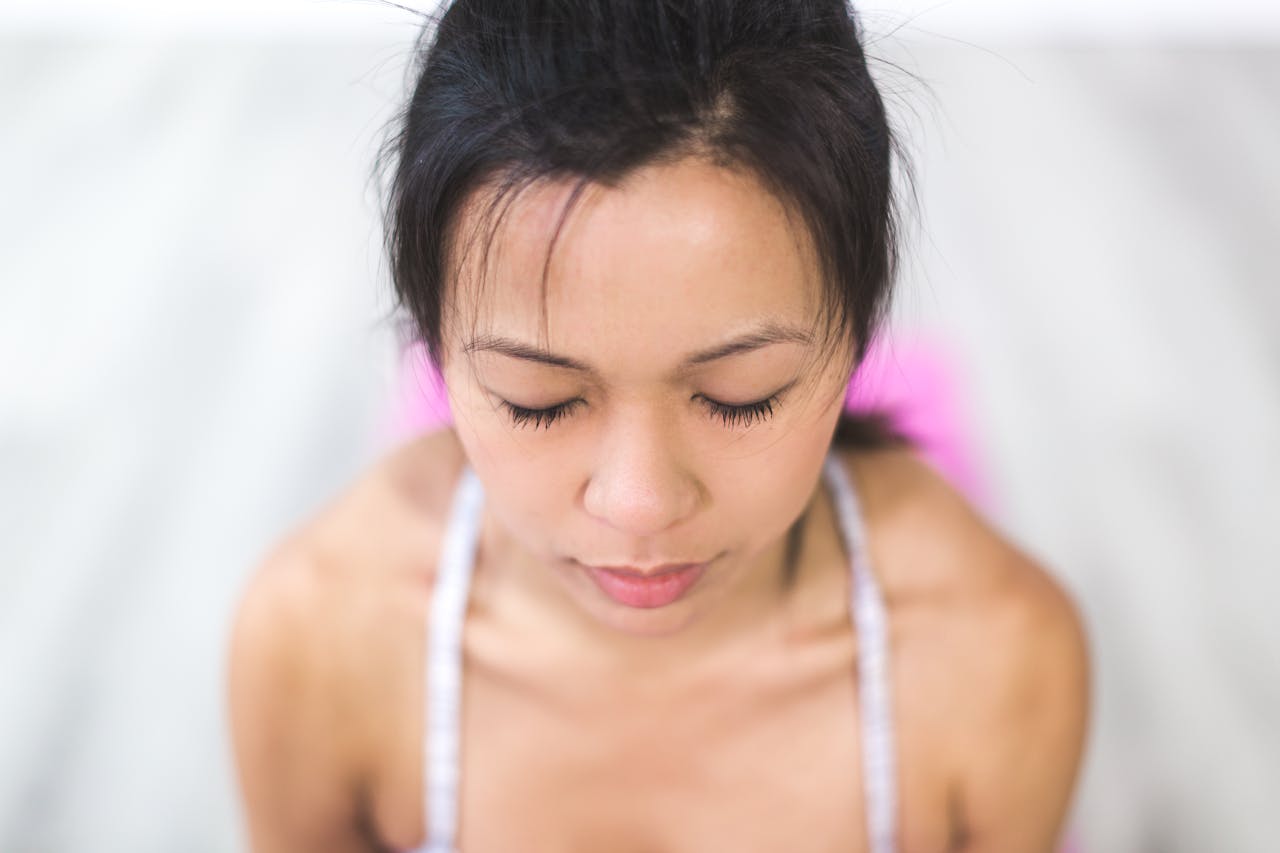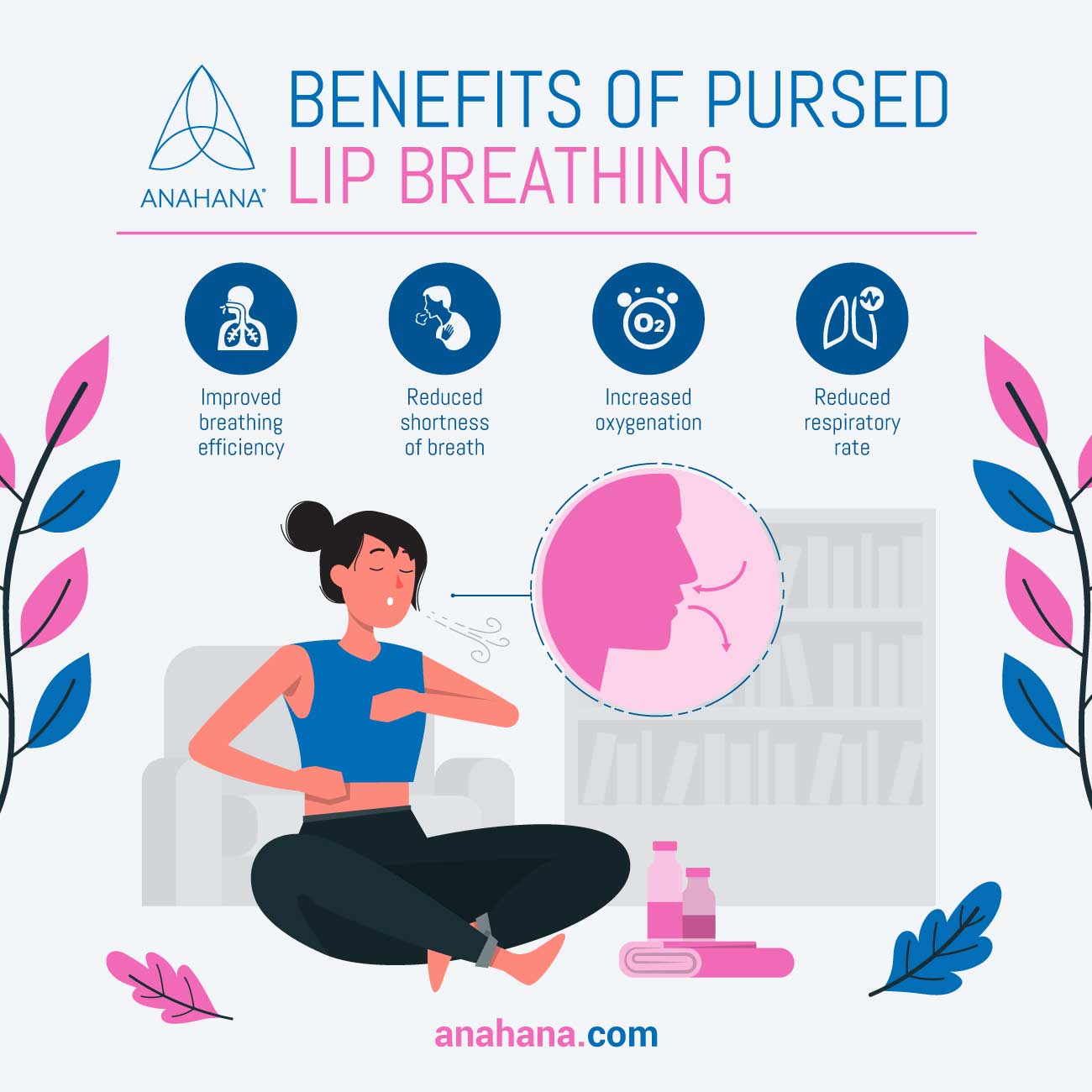
Table of Contents
Pursed lip breathing is a breathing technique commonly used to improve breathing efficiency and control in individuals with respiratory issues, such as chronic obstructive pulmonary disease (COPD) or asthma.
It involves inhaling slowly through the nose and exhaling through pursed lips, as if blowing out a candle, to create resistance and prolong the exhalation. This technique helps to release trapped air in the lungs, reduce shortness of breath, and enhance oxygen exchange.
The Science Behind Pursed Lip Breathing Technique
During normal breathing, the forces exerted during exhalation can cause airways without cartilage to collapse inward, leading to increased airway resistance and potentially trapping carbon dioxide. When carbon dioxide levels rise, the body responds by taking deeper breaths, but this can cause further carbon dioxide trapping and fatigue the respiratory muscles.
On the other hand, breathing exercises create positive end-expiratory pressure (PEEP). The positive pressure created opposes the forces exerted on the airways from the flow of exhalation, which helps open up more airway connections and alveoli, improving efficiency and reducing the need for increased breathing.
Ultimately, this moves old air out of the lungs and new air in to support breathing by opening the airways during exhalation and increasing the excretion of volatile acids in carbon dioxide, preventing or relieving hypercapnia. By increasing the pressure during exhalation and removing stale air, breathing exercises can prevent airway collapse and mitigate the effects of carbon dioxide trapping.
Benefits of Pursed Lip Breathing
Pursed lip breathing can offer several benefits, including:
-
Improved breathing efficiency: Pursed lip breathing helps slow breathing and prolong exhalation, allowing the individual to breathe more effectively and efficiently.
-
Reduced shortness of breath: This breathing technique can help relieve shortness of breath and improve overall breathing comfort, making it beneficial for individuals with lung diseases such as COPD and asthma.
-
Reduced respiratory rate: Pursed lip breathing can help to slow down an individual's breath rate, making it easier to control their breathing and avoid hyperventilation.
-
Reduced work of breathing: This technique can help to reduce the amount of work required by the respiratory muscles to breathe, making it easier for individuals with breathing difficulties to breathe comfortably.
-
Increased oxygenation: Pursed lip breathing can help ensure practitioners have enough oxygen reaching the lungs, improving overall oxygenation and reducing the risk of carbon dioxide buildup.
How to practice pursed lip breathing
-
To perform the technique correctly, the individual should find a comfortable position and begin by relaxing their neck and shoulder muscles and taking a few deep breaths to slow their breathing pace.
-
Inhale slowly through the nose for 2 seconds. (Note: Keeping the mouth closed can benefit dental health.)
-
Pucker the lips in a whistling or kissing position and exhale slowly.
-
Breathe out slowly and gently through the pursed lips for 4 seconds. (Note: The exhalation should be twice as long as the inhalation.)
-
Repeat steps 2-4 for several breaths, focusing on exhaling slowly and steadily.
Conditions that Benefit from Pursed Lip Breathing
 Pursed lip breathing is effective for individuals with obstructive lung disease like asthma and restrictive lung conditions like pulmonary fibrosis (PF). It is also effective for patients with other lung diseases, including chronic obstructive pulmonary disease (COPD).
Pursed lip breathing is effective for individuals with obstructive lung disease like asthma and restrictive lung conditions like pulmonary fibrosis (PF). It is also effective for patients with other lung diseases, including chronic obstructive pulmonary disease (COPD).
What is COPD?
COPD is a condition that severely impairs lung function and breathing ability, leading to overinflated lungs and reduced exhaling ability in later stages. Studies have shown that COPD patients can reduce dynamic hyperinflation and improve their breathing pattern, arterial oxygen, and exercise tolerance through pursed lip breathing.
This technique greatly enhances the quality of life of those with COPD, which cannot be cured or reversed. Even individuals experiencing minor respiratory distress can regain control of their breathing with pursed lip breathing. The relationship between COPD and pursed lip breathing goes beyond these benefits.
The Origins of Purse Lip Breathing
COPD patients discovered pursed lip breathing exercises when they realized that exhaling pursed lips was more effective than through their nose when they were desperate for oxygen.
Researchers quickly analyzed the technique and found that the slow, controlled flow of the technique creates back pressure, helping people exhale more completely. Inhaling through the nose and exhaling through the mouth clears out more oxygen with each breath, according to Dr. Brian L. Tiep's lung model experiments.
Dr. Tiep and Mary Burns conducted two studies to confirm the benefits of pursed lip breathing exercises. In the first study, COPD patients performed the exercise and saw increased oxygen concentration, which is common in pulmonary rehabilitation programs.
The second study involved patients with restrictive diseases like pulmonary fibrosis, who experienced an improvement in oxygen levels by doing pursed lip breathing. This exercise is now a part of treatment for patients who need extra oxygen, from pulmonary fibrosis to lung cancer.
Contraindications of Pursed Lips Breathing
The risk of using pursed lip breathing is low and takes time to become second nature. However, excessive use beyond a recovery method may lower carbon dioxide levels below normal ranges, potentially decreasing perfusion pressure in the brain and causing a blackout.
Additionally, prolonged use of this technique can lead to respiratory muscle fatigue and air trapping. The technique requires proper coordination to maintain prolonged exhalation.
Consult a healthcare professional if lung functions, such as breathing capacity or breathing rate, have decreased. Before attempting this technique for any existing medical conditions, including COPD, one should consult a doctor or another health professional.
Frequently Asked Questions
Are There Any Breathing Techniques Similar to Purse Lip Breathing?
Generally speaking, techniques that enhance lung function and breathing efficiency have a calming effect on the central nervous system to reduce stress and alleviate anxiety and panic disorders. For instance, diaphragmatic or belly breathing involves gently pressing on the abdomen while exhaling to push the air out. Other techniques include box breathing and Sama Vritti (equal breathing).
Can Pursed-Lip Breathing Help with Depression and Anxiety?
Pursed lip breathing may not have a significant impact on depression and anxiety in the long run, but it can help people calm down and improve oxygen intake temporarily.
This technique is commonly used for quick recovery when an individual needs an oxygen boost. In contrast, meditation is known to have a more significant impact on managing depression and anxiety.
Are Pursed Lips Breathing a Substitute for Emergency Care?
Pursed lip breathing exercise is a diaphragmatic breathing that can help improve breathing and manage shortness of breath. Still, it should not be used as a substitute for emergency care if there is a serious medical emergency or urgent need for medical attention. If there is any doubt or concern about the severity of the situation, it is best to seek emergency care immediately.
How often should people Perform Pursed Lip Breathing?
Practicing purse lip breathing four to five times daily is recommended until the simple technique is second nature. Once mastered, practitioners can perform the method anytime they feel short of breath, especially during climbing stairs, bending, or lifting something.
The contents of this article are provided for informational purposes only and are not intended to substitute for professional medical advice, diagnosis, or treatment. It is always recommended to consult with a qualified healthcare provider before making any health-related changes or if you have any questions or concerns about your health. Anahana is not liable for any errors, omissions, or consequences that may occur from using the information provided.
References
Pursed Lip Breathing - Healthline
Pursed Lip Breathing - National Library of Medicine
Pursed Lip Breathing - PubMed Study
Pursed Lip Breathing - Medical News Today
Pursed Lip Breathing Instructions - Michigan Medicine
COPD Breathing Exercises & Techniques - National Jewish Health
Breathing Techniques - COPD Foundation
Pursed Lip Breathing - Insider
Pursed Lip Breathing - Cleveland Clinic
Chronic Obstructive Pulmonary Disease (COPD) - CDC
Pursed Lips Breathing For People With Pulmonary Fibrosis - PERF
Disclaimer
The contents of this article are provided for informational purposes only and are not intended to substitute for professional medical advice, diagnosis, or treatment. It is always recommended to consult with a qualified healthcare provider before making any health-related changes or if you have any questions or concerns about your health. Anahana is not liable for any errors, omissions, or consequences that may occur from using the information provided.

By: Anahana
The Anahana team of researchers, writers, topic experts, and computer scientists come together worldwide to create educational and practical wellbeing articles, courses, and technology. Experienced professionals in mental and physical health, meditation, yoga, pilates, and many other fields collaborate to make complex topics easy to understand. Anahana is also home to specialists in crystals, tarot, angel numbers, astrology, life path numbers, zodiac signs, and horoscopes. By combining evidence-based wellness with spiritual and energetic practices, the team offers clear, trustworthy guidance for both mind-body health and modern spirituality.